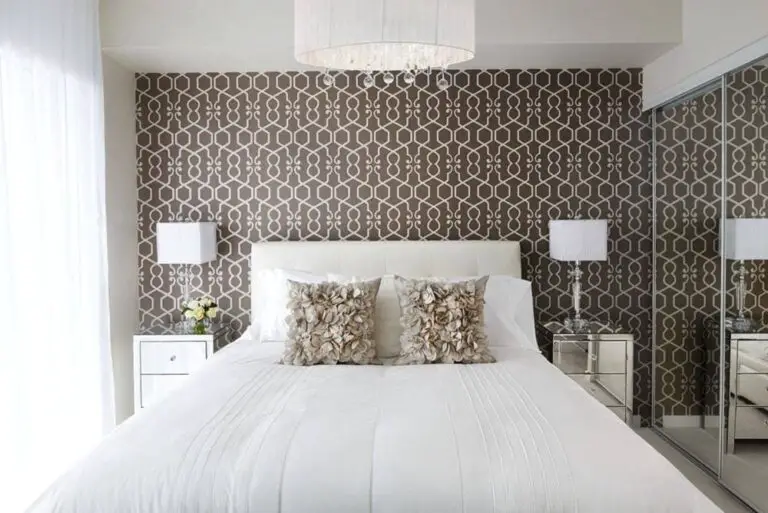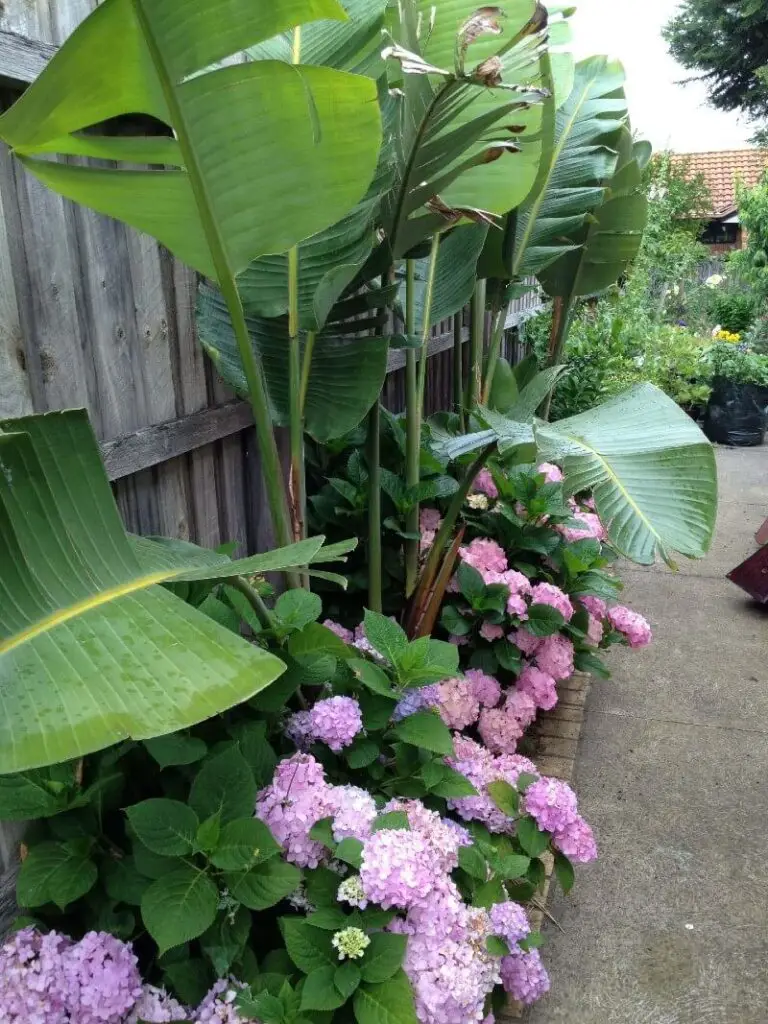8 Different Types Of Bedrooms (With Pictures)
Bedrooms are often the most personal spaces in our homes, serving as a reflection of our personality, taste, and lifestyle. Beyond aesthetics, choosing the right type of bedroom is crucial for creating a space that aligns with our needs, preferences, and the overall function of the room.
Whether it’s a master bedroom offering a retreat from daily stress, a guest bedroom providing warmth and welcome to visitors, or a child’s bedroom blending fun with functionality, selecting the perfect bedroom type can significantly enhance our living experience. In this article, we’ll delve into various types of bedrooms, exploring their unique features and how they cater to different needs and lifestyles.
As we navigate the world of bedrooms, you’ll gain a deeper understanding and valuable insights to guide your decision-making process in choosing the ideal bedroom for your home.
Our exploration will cover master bedrooms, designed for relaxation and comfort; guest bedrooms, crafted to make visitors feel at ease; children’s bedrooms, prioritizing safety and functionality; teenager’s bedrooms, balancing study and relaxation spaces; multipurpose bedrooms, striking a balance between function and comfort; small bedrooms, featuring space-saving solutions; attic bedrooms, maximizing unique architectural features; and basement bedrooms, considering legal requirements and safety considerations.
The Concept of Bedrooms
Definition and Purpose of a Bedroom
A bedroom is often viewed simply as a room for sleeping, but its significance extends far beyond that. A bedroom’s true nature is multifaceted, influenced by the individual’s needs, habits, and lifestyle. While it may serve as a sanctuary from life’s chaos for some, others may utilize their bedroom as a workspace, quiet retreat, or even a mini fitness studio.
Moreover, it can be a canvas for self-expression, where personal style and creativity are reflected through decor, furnishings, and accessories.
Factors That Influence the Choice of a Bedroom Type
When designing a bedroom, several factors converge to shape the final outcome. The interplay between these elements is crucial in creating a space that meets the needs of its occupant. To begin with, the size of the room plays a significant role. A compact bedroom may only accommodate a bed and a side table, whereas a spacious master bedroom can incorporate a seating area, workspace, or even a walk-in closet.
The person who will use the room also has a profound impact on the type of bedroom that suits them best. For instance, a child’s bedroom will have different requirements compared to a guest bedroom or a master bedroom. Furthermore, personal taste and style preferences come into play, with some individuals favoring modern minimalist designs and others leaning towards traditional or bohemian styles.
Budget is another critical factor, as it dictates the level of luxury and functionality that can be incorporated into the room. A limited budget may necessitate prioritizing essential furniture and functional elements, whereas a larger budget allows for high-end finishes, advanced technological features, and premium materials. Lastly, the architectural features of the room itself can also influence the bedroom type.
For instance, a room with large windows could create a light-filled, airy atmosphere, while a room with low ceilings might feel more cozy and intimate.
Master Bedroom
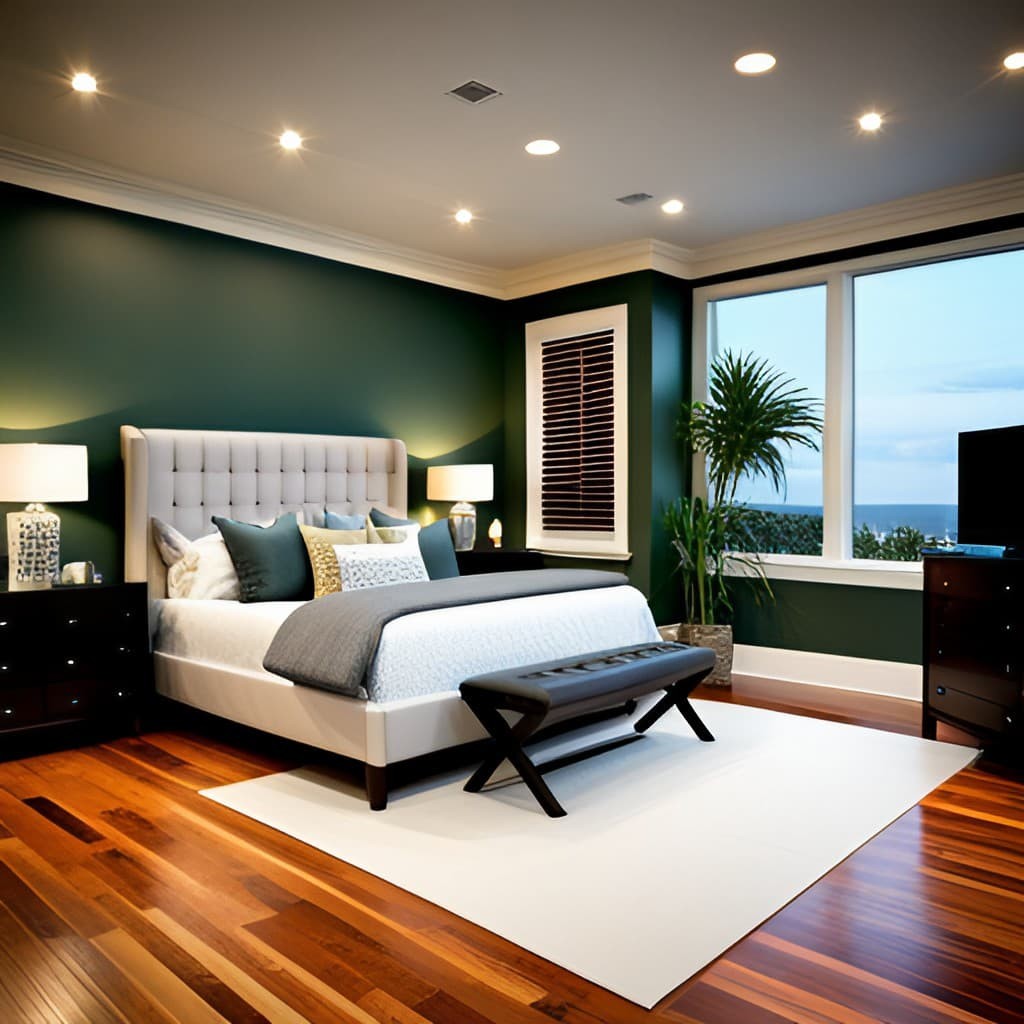
Description and Features
The master bedroom, typically the largest and most luxurious space in the home, serves as a serene retreat for its occupants. This private sanctuary is designed to provide unparalleled comfort and relaxation. One of the defining characteristics of master bedrooms is their often inclusion of advanced amenities, such as en-suite bathrooms, spacious walk-in closets, or even private balconies offering breathtaking views.
These features set them apart from other bedrooms in the home, making the master bedroom a truly unique and coveted space.
Ideal Uses and Benefits
A master bedroom serves as a tranquil retreat for homeowners, providing a serene environment to unwind and rejuvenate. With ample space, it can be designed to accommodate multiple functions, such as sleeping, reading, working, or even exercising, fostering a sense of relaxation and calm. The benefits of having a dedicated sanctuary are multifaceted, offering a private oasis away from the hustle and bustle of household activities.
The added features of an ensuite bathroom and walk-in closet bring an air of luxury and convenience, transforming the space into a true home-away-from-home experience.
Design and Decor Ideas
Designing a master bedroom is an exciting opportunity to create a sanctuary that reflects your personal style. Here are some key considerations:For a calming ambiance, opt for a soothing color scheme featuring soft neutrals, earth tones, or pastel hues. This will set the tone for relaxation. Quality furniture is essential for creating a comfortable and functional space. Invest in a plush bed, storage solutions that work well, and a cozy seating area where you can unwind.
Layered lighting is crucial for ambiance. Combine ambient, task, and accent lighting to create a warm and inviting atmosphere. To add personality to the room, display personal items, artwork, or photographs that reflect your style. This will make the space feel truly yours. For ultimate comfort, incorporate plush rugs, soft throw blankets, and a variety of pillows. These small details can make all the difference in creating a cozy retreat. Finally, don’t underestimate the impact of a feature wall.
Paint it in a bold color, add a mural, or create texture to add visual interest and depth to the room.
Guest Bedroom
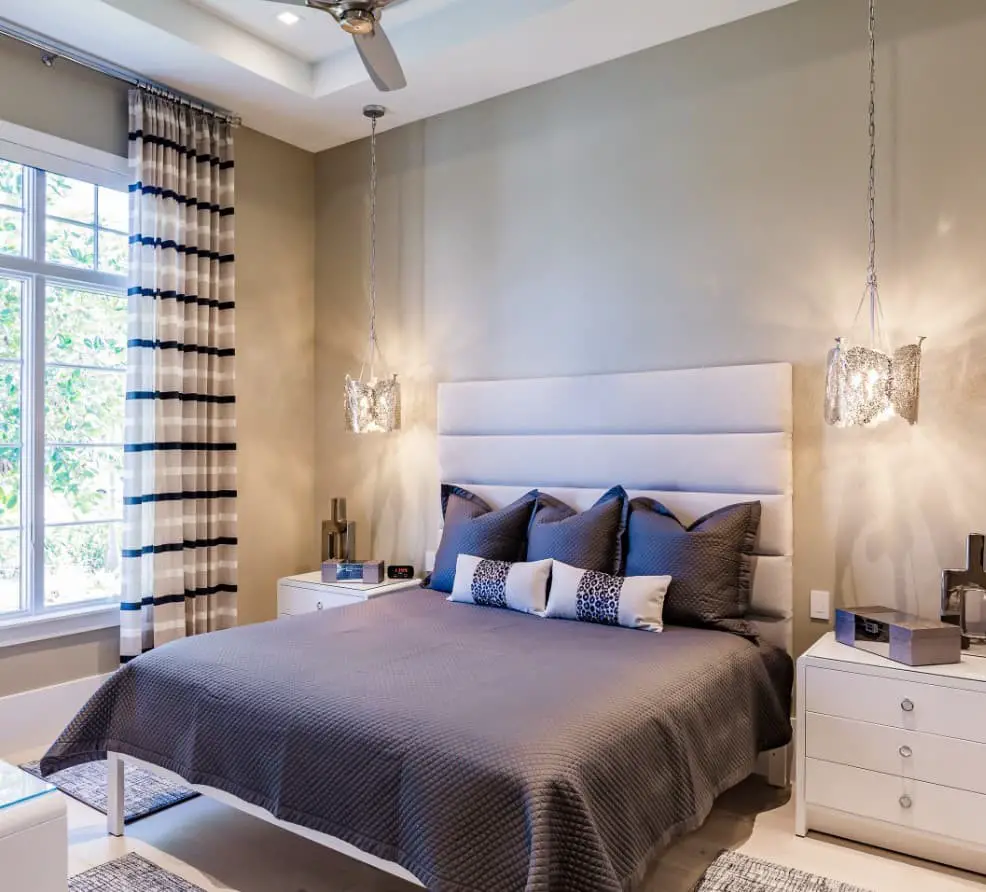
Description and Features
A guest bedroom serves as a welcoming space within your home, designed to cater to the needs of visiting friends and family. Typically, it features a cozy bed, ample storage for luggage and personal belongings, and may also include thoughtful amenities to enhance the overall experience. Despite being smaller in size compared to master bedrooms, a well-designed guest room should still exude warmth and comfort, making visitors feel at ease.
How to Make Guests Feel Welcome
Creating a warm and inviting atmosphere for your guests is all about attention to detail. Here’s how you can go above and beyond:Start by ensuring the bed is a haven they’ll love to rest in. Fresh linens, plush pillows, and soft blankets will make them feel right at home. Next, set up a bedside station with essentials like a lamp, alarm clock, tissues, and a water carafe. You might also consider providing a toiletry basket for any last-minute items they may have forgotten.
Make it easy for your guests to get what they need by keeping towels within reach. A fresh, fluffy towel can make all the difference after a long day of travel. When it comes to the rest of the house, take pride in its tidiness and stock the fridge with their favorite treats. This thoughtful touch will make them feel appreciated. Don’t forget to give your guests some breathing room. Ensure there’s enough closet or drawer space for them to unpack and settle in without feeling cramped.
Finally, add a personal touch by leaving a heartfelt welcome note or surprising them with a small bouquet of fresh flowers. Last but not least, don’t underestimate the power of snacks and drinks. A basket of fresh fruit, healthy snacks, chocolates, and bottled water can be a lovely surprise that’ll make your guests feel truly valued.
Design and Decor Ideas
When it comes to designing a guest bedroom, the goal is to create a cozy and welcoming space that caters to diverse tastes. To achieve this, consider the following key elements.
Firstly, opt for a neutral color palette for the walls and bedding, which will foster a serene and calming atmosphere. This understated approach allows your guests to unwind and feel at ease.
Next, prioritize comfort by investing in high-quality bed linens, pillows, and blankets that ensure a restful night’s sleep.
Don’t forget about functional furniture pieces like bedside tables, reading lamps, and chairs that add convenience and practicality to the room.
To give your guest bedroom a more personal touch, consider adding artwork, books, and decorative items that reflect your personal style or share a special story. This thoughtful approach will make your guests feel valued and appreciated.
Finally, don’t forget about the little extras that can elevate the overall experience.
Providing amenities like a coffee maker, selection of teas, or toiletries basket can go a long way in making your guests’ stay more enjoyable.
Children’s Bedroom
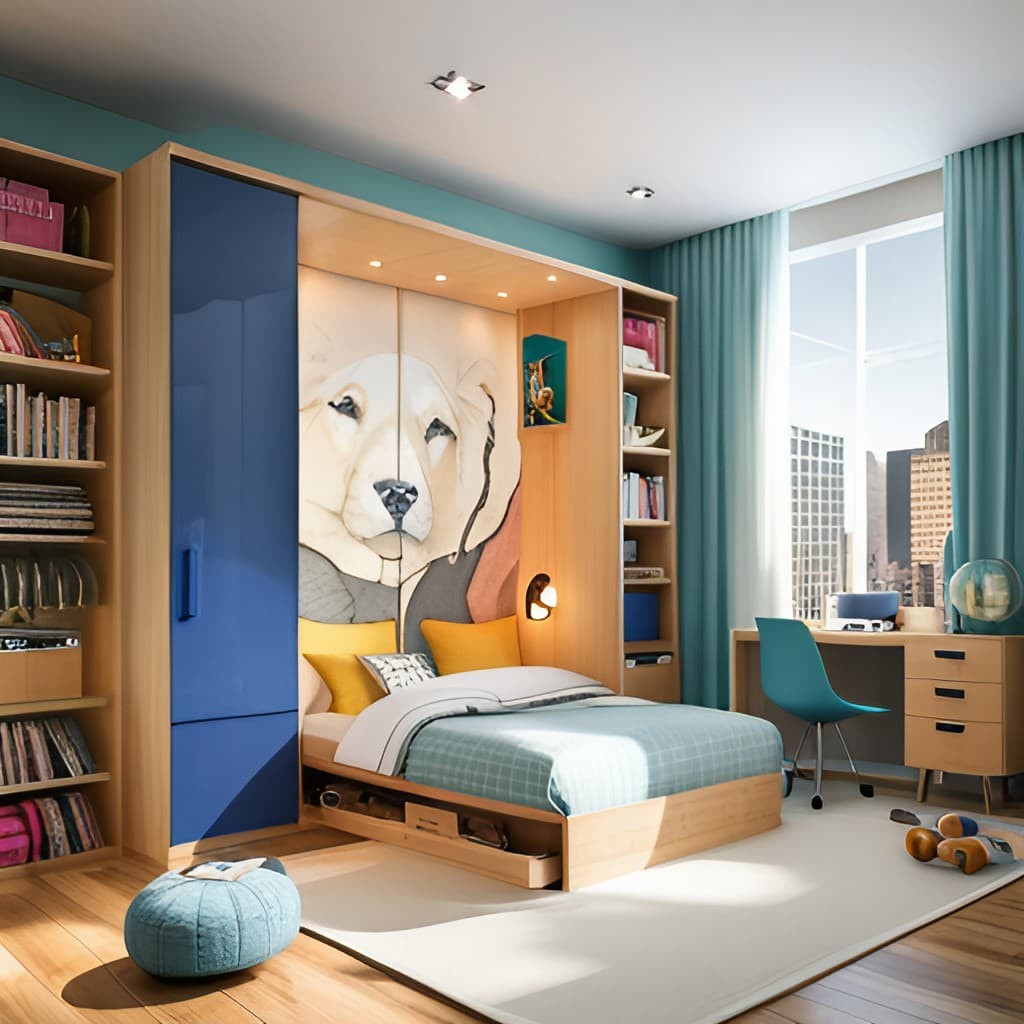
Description and Features
A child’s bedroom is a tailored space that caters to their unique needs, preferences, and interests. This cozy sanctuary typically features a bed or bunk beds for restful nights, a dedicated desk for homework and creative pursuits, ample storage solutions for toys and clothing, as well as a designated play area to encourage imagination and exploration.
Ideally, the room should strike a balance between functionality, visual stimulation, and personal expression, creating a haven that truly reflects the child’s individuality.
Safety Considerations
When it comes to setting up a child’s bedroom, safety should be the top priority. To ensure your little one has a secure and comfortable sleeping space, consider the following essential factors:
Furniture stability is crucial – make sure all pieces are sturdy and won’t topple over, especially bookcases and dressers that can easily tip.
Windows pose another potential hazard, so install window guards or stops to prevent falls.
Keep furniture at least three feet away from windows to discourage climbing.
Electrical safety is also vital – use safety plugs in unused outlets and keep cords tidied away to avoid tripping hazards.
When it comes to materials, opt for non-toxic options for furniture, paint, and bedding to create a healthy environment.
Sharp edges can be another hazard, so choose rounded-corner furniture and steer clear of glass tables or other items with sharp edges.
Finally, ensure rugs are securely fastened with non-slip pads to prevent slips and falls. By considering these crucial factors, you’ll be able to create a safe and cozy bedroom for your child.
Design and Decor Ideas
Designing a child’s bedroom is an exciting opportunity to create a space that reflects their unique personality and interests. Here are some inspiring ideas to get you started:
Firstly, consider a theme that resonates with your child’s passions, whether it’s animals, space exploration, fairy tales, or superhero adventures. This can help guide your design decisions and add an extra layer of fun.
Next, think about the color palette.
Bright, cheerful hues can create a stimulating environment that encourages creativity and play. You can also use different colors to define distinct areas within the room – for instance, a soothing blue for the sleeping area and a vibrant yellow for the play zone.
Storage is another crucial aspect of designing a child’s bedroom. Aim to incorporate plenty of options for toys, books, and clothes. Open shelves, baskets, and under-bed storage can help maximize space and keep the room tidy.
Personal touches are essential in making the space truly special. Consider displaying your child’s artwork, photos, or their name prominently on the wall.
Finally, think about incorporating interactive elements that foster imagination and creativity. Chalkboard walls, cozy reading nooks, or a playful tent can make the room a joyous place for your child to be.
Last but not least, remember to choose furniture and decor that can grow with your child.
A convertible crib that transforms into a toddler bed, adjustable desks, and timeless decorations can save you time and money in the long run.
Teenager’s Bedroom
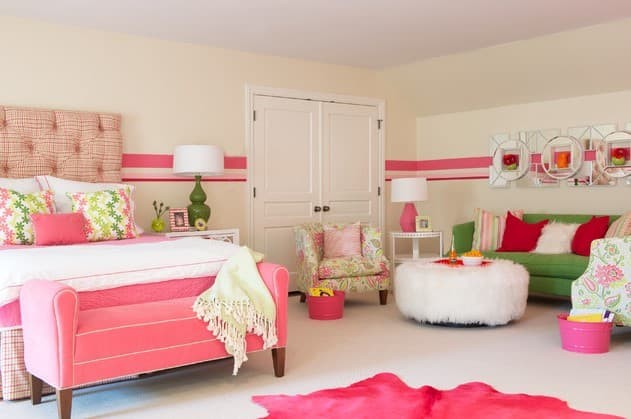
Description and Features
A teenager’s bedroom is a multifaceted space that serves as a haven for self-discovery, rejuvenation, and academic pursuits. It’s where they can let their guard down, be themselves, and cultivate their unique interests. A typical teenage bedroom features a bed, a designated study zone with a desk and chair, ample storage for personal belongings and clothing, and often an area dedicated to hobbies or unwinding.
Creating a Space for Study and Relaxation
A teenager’s room should strike a harmonious balance between functionality for academic pursuits and comfort for unwinding. To achieve this equilibrium, consider the following guidelines:
Functionality Meets Comfort: Designate a well-lit workspace with an ergonomic chair, adequate storage for textbooks, supplies, and devices, and proximity to a power source for charging purposes.
Cozy Corner: Create a secluded nook for relaxation, featuring a plush seating option, such as a bean bag or hammock. Soft lighting, throw blankets, and pillows can further enhance the ambiance.
Personal Touches: Reserve space for displaying personal items, including photographs, posters, memorabilia, or artwork. This allows the room to reflect their unique personality and sense of ownership.
Storage Harmony: Offer a variety of storage options to maintain a clutter-free environment.
Combine closets, shelves, under-bed storage, and organizers to accommodate their needs.
Design and Decor Ideas
When designing a teenager’s bedroom, the goal is to strike a balance between reflecting their unique personality and ensuring practicality. To achieve this, consider the following design ideas: Start by involving your teen in selecting a color scheme that resonates with their tastes – from soothing pastels to bold and vibrant hues. Then, think about incorporating a theme that revolves around their interests, such as sports, music, art, or travel.
This can be achieved through furniture choices, wall decor, or accessories. Next, prioritize functional yet stylish furniture pieces, like loft beds with desks underneath, which can be a game-changer in small rooms. To add personality to the space, utilize wall decor that reflects their interests, such as posters of their favorite bands, collages of photos, or large decals.
Lighting is also crucial – aim for layered lighting that includes ambient illumination for general purposes, task lighting for studying or reading, and accent lighting to highlight decorative elements or create a cozy atmosphere. Finally, opt for items that can adapt as your teen grows and their tastes evolve, such as neutral furniture that can be updated with different accessories over time.
Multipurpose Bedroom
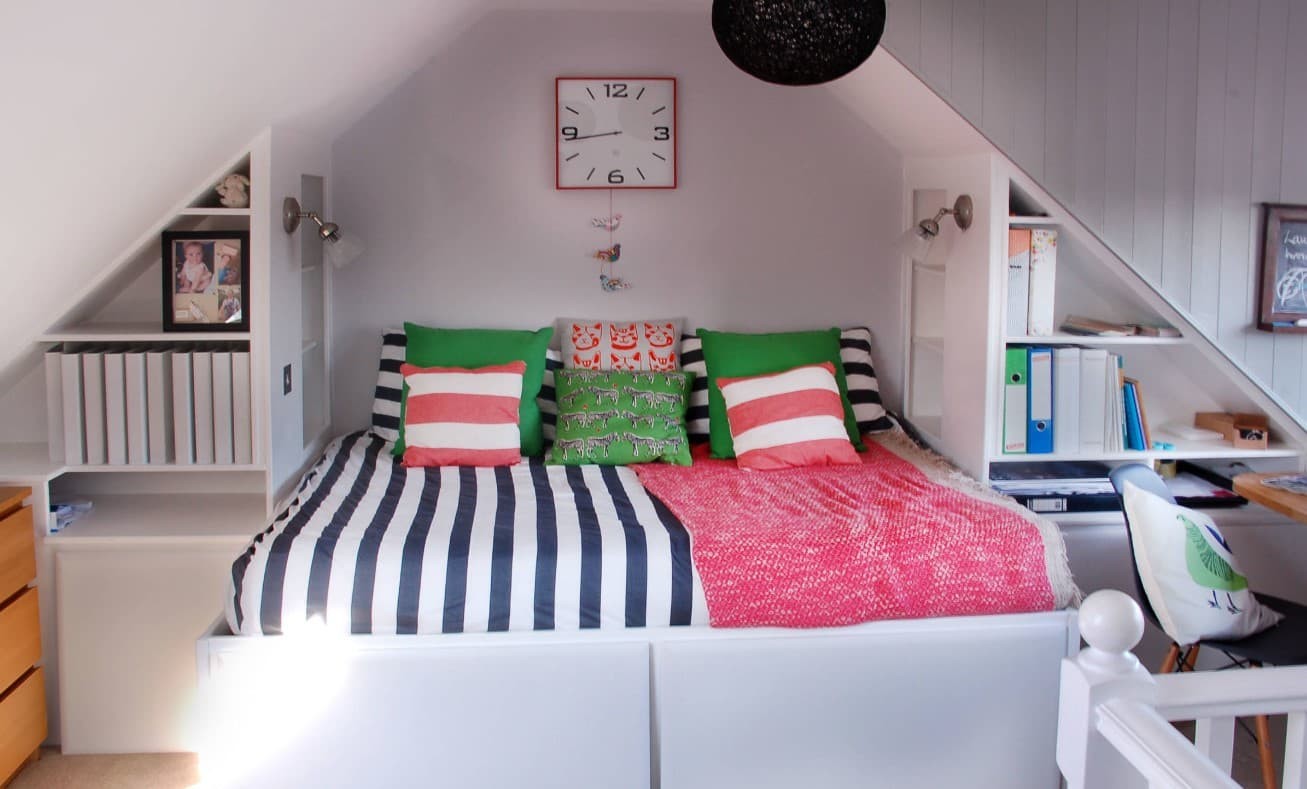
Description and Features
In modern living spaces, the traditional notion of a bedroom as solely a sleeping quarters is being redefined. A multipurpose bedroom is designed to accommodate multiple functions, transcending its primary purpose. This versatile space can seamlessly transform into a home office, workout room, lounge area, or even a dedicated hobby zone.
The defining characteristics of a multipurpose bedroom include a plush and inviting bed as the central anchor, paired with practical furniture pieces such as desks, sofas, or reading nooks that facilitate various activities. To complete this harmonious blend of functions, ample storage solutions are crucial to keep the space organized and clutter-free.
Through clever zoning and layout design, a multipurpose bedroom can effortlessly shift from relaxation mode to productivity mode, and back again – all within the same room.
Balancing Functionality with Comfort
To create a harmonious multipurpose bedroom, it’s essential to strike a balance between functionality and comfort. One approach is to zone the room into distinct areas for different activities, using furniture placement, rugs, or screens to define each space.
In addition to zoning, selecting multi-functional furniture can help to simplify the design process.
For example, a desk that doubles as a bedside table or a daybed that serves as both a sofa and bed can be highly effective in maximizing space while minimizing clutter.
Smart storage solutions are also crucial in keeping the room tidy. Consider using under-bed storage, wall-mounted shelves, or multifunctional furniture like a storage ottoman to keep essential items out of sight.
Lighting is another key consideration, as different activities require different types of illumination.
A combination of ambient lighting for general illumination, task lighting for work or reading, and softer lighting for relaxation can help to create a comfortable and inviting atmosphere.
Finally, it’s essential to add personal touches to the room, even though it serves multiple purposes. This might include hanging photos, displaying artwork, or incorporating decor that reflects your personal style.
Design and Decor Ideas
To transform your bedroom into a versatile retreat, you’ll need to strike the right balance between aesthetics, functionality, and practicality. Here are some innovative approaches to consider:
A harmonious backdrop: A neutral color palette can create a sense of unity and visual calmness in the room, making it feel more spacious and radiant. To inject some personality, incorporate pops of color through accessories and decorative elements.
Adaptable essentials: Invest in furniture pieces that are designed to be flexible, such as desks with wheels or modular shelving systems. These will enable you to reconfigure your space according to changing needs.
Reflective surfaces: Strategically placed mirrors can not only create the illusion of a larger room but also serve as functional elements for fitness or dressing routines.
Zoning strategies: Use area rugs to carve out distinct zones within the room, each with its own unique character. These textiles will also add warmth and coziness underfoot.
Natural touches: Incorporate low-maintenance plants that thrive in indoor environments to purify the air, promote relaxation, and create a calming ambiance.
Small Bedroom
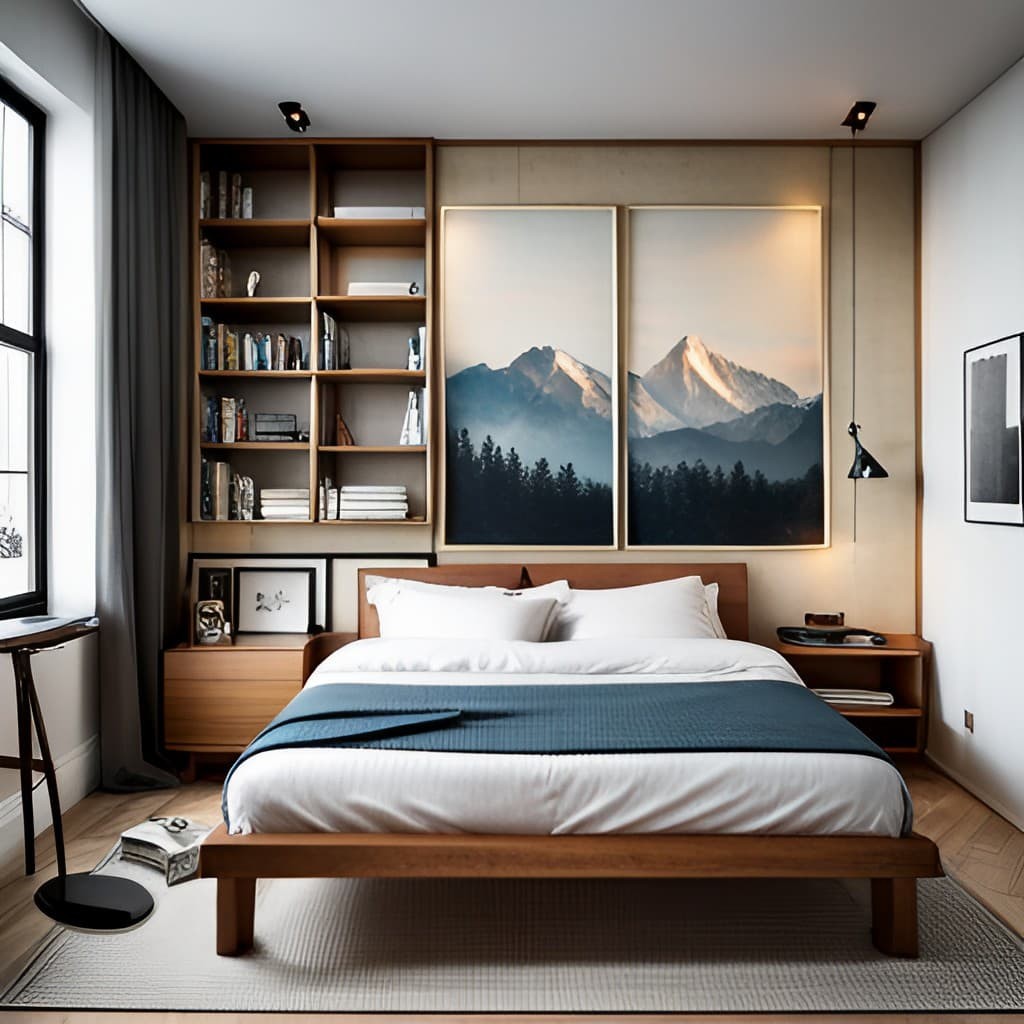
Description and Features
In spite of its compact dimensions, a small bedroom can evolve into a warm, efficient, and tasteful retreat. To achieve this, it’s essential to approach design with intentionality, carefully balancing space constraints against the need for comfort and style. Key elements typically include a plush bed, strategically designed storage solutions, innovative furniture arrangements that multitask, and thoughtful utilization of color and light to create an illusion of spaciousness.
Space-Saving Tips
Investing in smart furniture solutions is a great way to maximize your living or work space. Consider pieces that can serve multiple purposes, such as beds with built-in storage or wall-mounted desks that save valuable floor real estate. Additionally, take advantage of vertical space by incorporating tall shelves, hooks mounted on doors, or hanging organizers that make the most of your room’s ceiling height.
To further optimize your space, consider utilizing under-bed storage containers for items like seasonal clothing, bedding, or shoes that you don’t need immediate access to. Mirrors are also a clever way to create the illusion of more space by reflecting light around the room and making it feel brighter and larger than it actually is. Finally, commit to regularly decluttering your space to maintain a sense of calmness and openness.
By doing so, you’ll be able to appreciate your well-designed and efficiently used area with ease.
Design and Decor Ideas
When it comes to designing a small bedroom, the key is to create an airy and inviting atmosphere without overwhelming the senses. Here are some effective strategies to achieve this:One approach is to opt for a calming color palette that doesn’t visually weigh down the space. Soft whites, pale greys, or gentle pastels can help make the room feel larger and more radiant.
For a small bedroom, it’s often best to adopt a minimalist aesthetic, focusing on only the most essential furniture pieces and keeping accessories to a minimum. This can create a sense of serenity and openness that belies the room’s actual size. Lighting is crucial in any bedroom, but especially so in a smaller space where darkness can feel more pronounced.
In addition to a central light source, consider incorporating bedside lamps or wall-mounted lights to provide additional illumination without sacrificing visual real estate. To avoid cluttering the walls and creating a sense of visual chaos, it’s often better to opt for one large piece of art rather than multiple smaller pieces. This can create a beautiful focal point that draws the eye and opens up the room.
Finally, don’t underestimate the impact that a well-chosen rug can have on the overall ambiance of your small bedroom. A high-quality rug can not only define the space but also add warmth and coziness to what might otherwise feel like a chilly or impersonal environment.
Attic Bedroom

Description and Features
An attic bedroom is a charming retreat that often gets overlooked, but with the right design touches, it can be transformed into a snug and inviting space. Characterized by its sloping ceilings and compact layout, an attic bedroom presents a unique opportunity to get creative with storage solutions, natural light, and architectural features.
From beds carefully selected to fit the room’s quirky shape to cleverly designed skylights that flood the space with sunlight, an attic bedroom can be a true showstopper.
Making the Most of Unique Architectural Features
Transforming an attic bedroom into a unique retreat requires creative thinking and utilization of its distinctive architectural features. Here are some innovative ways to take advantage of the sloped ceilings, recessed eaves, exposed beams, and limited vertical space:
Elevate Sloped Ceilings: Instead of viewing them as a constraint, turn the sloped ceilings into a statement piece by incorporating wood paneling, bold paint colors, or eye-catching wallpaper.
This will draw attention to these unique shapes and add visual interest.
Carve Out Niches: The eaves recess in an attic can be transformed into a dramatic feature. Carve out niches for a cozy reading nook, a built-in desk, or additional storage, thereby maximizing the space and creating a sense of depth.
Illuminate with Skylights: To maximize natural light and create an illusion of more space, consider installing skylights in your attic bedroom.
This will not only bring in ample light but also add a touch of drama to the room.
Emphasize Exposed Beams: If your attic features exposed beams, utilize them to add character to the room. You can paint or leave them natural, depending on your preferred decor style. This will create a sense of warmth and coziness in the space.
Built-in Beds: To maximize space and work with the room’s unique shape, consider installing built-in beds.
This design approach not only saves floor space but also creates a sleek, streamlined look.
Design and Decor Ideas
When crafting an attic bedroom, imagination and thoughtful planning are essential. To bring this space to life, consider the following ideas:
Infuse Cozy Charm: Incorporate natural textures like wood and wool to create a warm, inviting atmosphere reminiscent of a rustic cabin.
Elevate with Luxury: Introduce plush bedding, sophisticated lighting, and refined furniture to transport you to a high-end boutique hotel.
Vintage Revival: Embellish the space with vintage-inspired decor and accessories for a charmingly nostalgic ambiance.
Airy Openness: If the layout permits, maintain an open concept design to create a sense of spaciousness and airiness in the attic bedroom.
Frame the View: Should your room boast a window with a stunning view, cleverly frame it with custom-crafted curtains to draw attention to this focal point.
Basement Bedroom
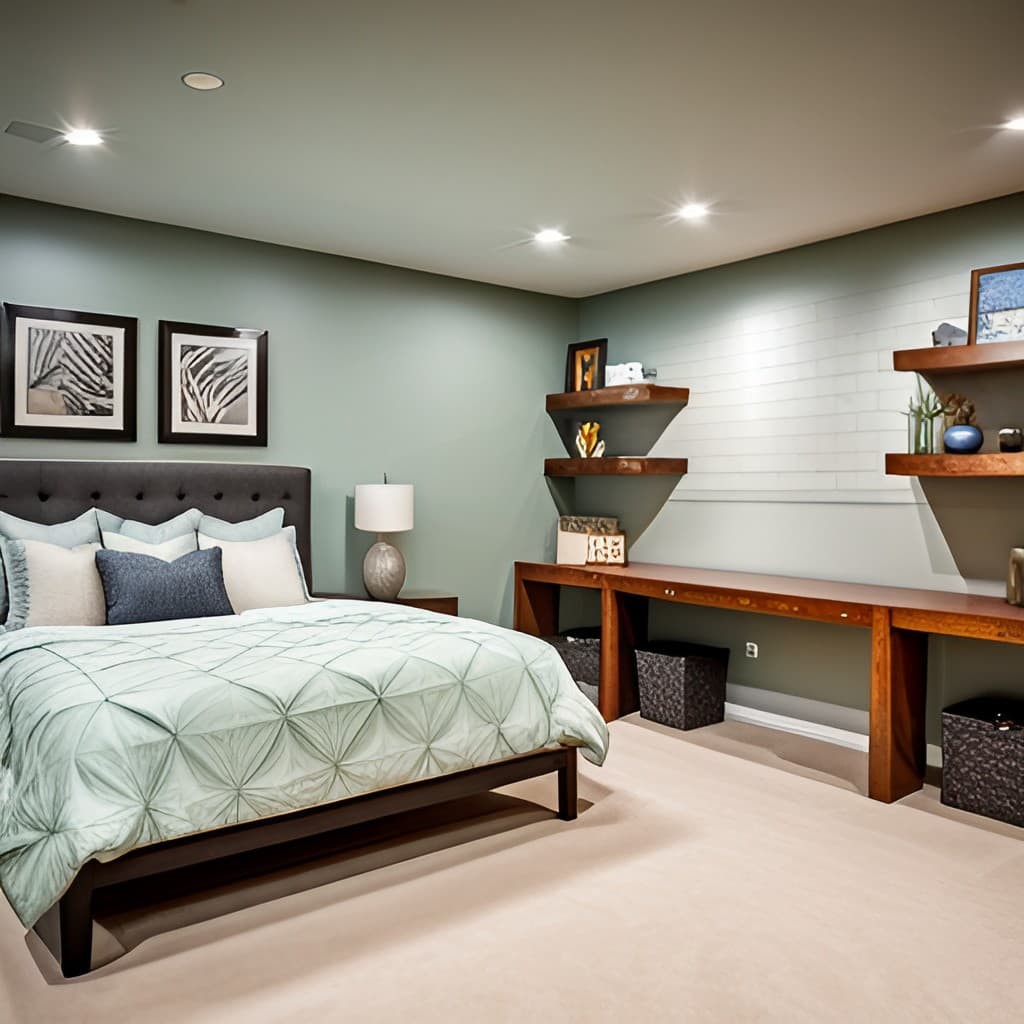
Description and Features
A basement bedroom is an innovative living space born from the transformation of an underground area. Its distinct charm stems from the limited natural light it receives and the presence of unique architectural features like exposed beams or brick walls.
While designing a basement bedroom, some essential elements to consider include a comfortable bed, sufficient lighting to compensate for the lack of natural light, clever storage solutions, and in many cases, a small window that not only provides a glimpse of the outside world but also ensures safety.
Legal Requirements and Safety Considerations
In order to qualify as a habitable bedroom, a basement room must meet specific regulatory standards. The primary considerations include:
Ceiling Height: A minimum clearance of 7 feet is necessary to ensure comfortable movement and avoid any hazards.
Square Footage: At least 70 square feet of floor space is required for the room to be considered suitable for sleeping quarters.
Egress Window: A window that serves as an exit in case of emergency, providing a safe means of escape from the premises. This is a crucial safety feature that must be incorporated into any basement bedroom design.
Ventilation: Proper airflow and ventilation are vital for maintaining a healthy indoor environment and preventing mold growth, which can have significant implications for occupant health.
It’s essential to consult with local building authorities or qualified contractors to confirm compliance with all relevant regulations and safety guidelines when converting a basement into a bedroom.
Design and Decor Ideas
Designing a basement bedroom requires creativity and planning. Here are some key considerations:First, think about lighting. A combination of ambient, task, and accent lighting can create a warm and inviting atmosphere. This will help make the most of your basement’s unique features. Next, consider how you’ll use the space. Basements come in all shapes and sizes, so it’s essential to plan your layout carefully.
For instance, if you have a long basement, think about dividing it into separate areas for sleeping, lounging, or working. Built-in shelving and nooks are also great ways to add functionality while keeping the floor clear. These features can provide valuable storage and display space for your belongings. Warm colors and natural elements like wood or stone can also help create a cozy and inviting ambiance.
A neutral palette can even help reflect light around the room, making it feel brighter and more spacious. By considering these factors, you’ll be well on your way to designing a basement bedroom that’s both functional and comfortable.
Conclusion
Bedrooms serve as the sanctuaries of our daily lives, regardless of their size or location. We’ve delved into three unique types – small, attic, and basement bedrooms – each presenting its own set of characteristics and challenges. Despite these differences, all can be transformed into cozy, functional, and stylish spaces that truly reflect our personalities.
Small bedrooms require innovative approaches to maximize space and minimize clutter, while attic bedrooms offer the opportunity to capitalize on distinctive architectural features like sloped ceilings and nooks. Basement bedrooms, often overlooked, can become warm and inviting with thoughtful lighting and design elements, taking into account necessary safety considerations and legal requirements. The importance of personalizing these spaces cannot be overstated.
A bedroom should be a reflection of one’s tastes, needs, and lifestyle – whether minimalist, cozy, vintage, or modern. As you embark on designing your bedroom, remember that intentional planning is crucial. Consider your available space, natural light, unique architectural features, and incorporate color, texture, and personal touches to create a space that truly feels like home. Ultimately, your bedroom should be a haven where you feel comfortable and at peace.
Take your time, plan carefully, and most importantly, have fun with the process. Creating a space that reflects your personality is a journey worth savoring.
Related Posts
When it comes to furnishing your bedroom online, there are countless options available. Here’s a comprehensive review of the top 45 retailers that offer high-quality and comfortable bedroom furniture, ensuring you find the perfect piece to complete your dream bedroom. Additionally, we’ve got you covered with our expert recommendations on the best places to buy pillows online, featuring top 28 stores for comfort and quality.
If you’re looking to create a harmonious color scheme, we reveal what color bedding goes well with gray headboards, providing perfect matches for a chic and inviting bedroom atmosphere. For Airbnb hosts seeking to elevate their guests’ experience, our expert picks highlight the top 12 best futons for sleeping in 2024, ensuring a restful night’s sleep.
Moreover, we’ve curated the best bed bug pillow covers for 2024, featuring top picks from experts that guarantee ultimate protection and peace of mind.

